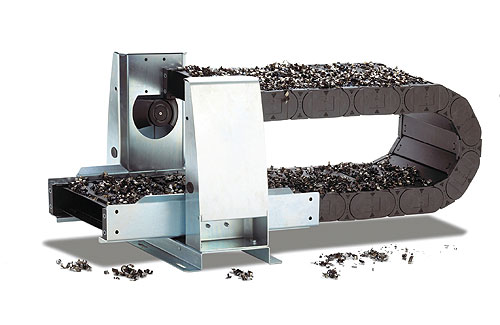Motion control systems can vary from simple, straightforward single-axis direct-drive systems with little wiring to large and complex multi-axis robotic systems with a hornet’s nest of cables. This is usually where cabling, which was an afterthought, now takes center stage.
Especially where there are lots of cables and wiring, cable management becomes an issue. A simple form of cable management uses twist-tie type bundlers that tie together groups of wires and cables. These are low cost and easy to use. The problem is that with more and more cabling, they become impractical. Also, if the wiring and cabling have to be suspended, bundling them together may pose weight problems which cause sagging and put undue strain on the cables.
Using cable carriers is another option. Cable carriers are essentially structures designed to house cables. The structures themselves can be made of many materials such as plastic, steel, or a metal alloy. Cable carriers are used to protect cables and hoses on moving machinery. They prevent tangling and increase safety by not having cables susceptible to getting caught in moving parts of a machine. Applications for cable carriers can range from machine tools and robotics to cleanroom applications and large industrial equipment like cranes and other construction machinery.
Carriers can house a large volume of cables and wires and support the weight of them all without sagging or putting stress on the cabling. They also make managing and routing the cables through a machine or factory much simpler and provide easy access for troubleshooting or maintenance as well.
Selecting the right kind of cable carrier for an application starts with a few simple guidelines. The most important points to consider are the specifics of the application. These include the length of travel, the number of cables or hoses, the size and weight of the cables, the required speed and acceleration and environmental factors such as exposure to any debris, excessive heat or chemicals. Knowing the weight of the cables ensures that the carrier won’t fail by snapping in two.
Cable carrier styles can be either open or closed. Open varieties allow for easy access to the cables and visible access as well, whereas closed carriers seal off the cables from the environment to protect from environmental contaminants such as metal filings.
Environmental conditions play a large part in selecting a cable carrier. If the application is in a dirty or contaminated area, an enclosed carrier is the best choice. An open carrier is lightweight and makes inspecting and replacing cables easier.
Another important consideration is the bend radius of the cable carrier. Bend radius is measured from the center of the curve loop to the center of the pivot pin on the side link. A larger bend radius means less stress on the cable and a longer service life.



Leave a Reply
You must be logged in to post a comment.